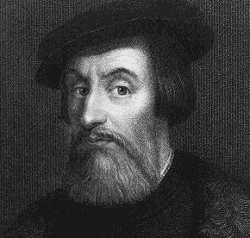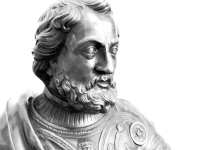Hernan Cortez biography
In this brief Hernan Cortez biography, we'll try to learn a bit more about the man who tried to conquer the Aztec empire. In one sense, he did conquer it. In another sense, it lived on in spite of all that Hernan Cortes and his army tried to do.
 |
Hernándo Cortés Pizarro was his full name in Spanish. He was born in 1485 in the kingdom of Castile (now a part of Spain) in the city of Medellín. His was an upper class family, though his parents weren't wealthy. He was somewhat sickly as a child, and the family's only son.
At the age of 14, his parents sent him to the University of Salamanca to eventually study law. But he wasn't happy at school, too restless to follow the rules. He did learn a little Latin, and became good at writing. After two years (failing his course) he returned home, but wasn't happy there either. As stories began to come in about the mysterious "New World", Hernan Cortez wanted to be a part of it.
After a time of doing not much, he decided to follow the life of a soldier. He joined an expedition to the New World, but never made it on board.
He was involved in an affair with a local girl. One night he was climbing a wall to get to her apartment, and the wall gave way. He crashed down, buried under the rubble, and was stuck in bed until after his ship had departed.
Hernan Cortez biography - the New World
Finally, in 1504, Hernan Cortes boarded a ship commanded by Alonso Quintero, departing for the west. Quintero was ambitious. More than once he tried to sneak away from his companions, so that he could secure the market for himself. He was not very successful, but perhaps his ambition rubbed off on the young Cortes.
In Hispaniola (Now Haiti and the Dominican Republic) Cortes went to the house of the Governor, who he knew from Spain. The Governor was gone, and the secretary assured him that he would be able to get a land grant. "But I came to get gold," he replied, "not to till the soil, like a peasant."
When the Governor returned, Hernan Cortez was finally convinced to take a piece of land for a time. He didn't entirely settle down, though. He was involved in the military, suppressing native uprisings. He was also often in duels over one girl or another.
Over the next few years, Hernan Cortes took part in conquests of Cuba and Hispaniola, and received more land an native slaves as a result. He became an important man in the colony of Cuba, and he became mayor of Santiago. Eventually, he married the sister-in-law of Governor Velázquez, Catalina Xuárez.
A whole other Hernan Cortez biography could be written about this time in his life. He had a very troubled time, even being put in jail at one point. He was very dissatisfied with his life, remaining ambitious for more wealth, more slaves, more adventure.
Hernan Cortez biography - on to Mexico!
Mexico was just newly discovered when Hernan Cortes was allowed to lead a small expedition to explore. The Governor actually changed his mind and cancelled the expedition, but Cortes went anyway on February 18th. It was 1519 - he would have been about 34 years old.
Cortez quickly took control of the situation. Landing in the Yucatán, he met Jeronimo de Aguilar, a Franciscan priest who knew Mayan. Cortes claimed the land for Spain, and began his conquest. He met his future mistress, who knew Mayan and Nahuatl (the language of the Aztecs). Taking his men to Veracruz, he officially ignored the authority of the Governor and claimed to be acting under the direct authority of Emperor Charles V. In reality, he was taking charge of the situation absolutely, and ready to claim the gold and power he had been looking for.
You can read about Hernan Cortes and the fall of Aztec Mexico here.
Life in New Spain
Hernan Cortes was to become the governor of New Spain, which is what his new territory was arrogantly called. He was constantly seeking to consolidate his power, increase his wealth, and put down his enemies. He also built Mexico City over the old Aztec Tenochtitlan. He sponsored exploration, the building of more cities, and the Roman Catholic evangelization of the native population. He also promoted the early sugar industry.
But in 1526 he was suspended in his role as Governor. He retained much of his power, but was increasingly opposed by his enemies. Suspected of poisoning new leadership, he returned to Spain in 1528. He would never be governor again.
He was decorated by the emperor, and returned to New Spain in 1530. After more fighting to prove his innocence and to reestablish his position of power, he decided to live in Cuernavaca, where he built his palace. He also continued exploring the Pacific coast and Baja California. His later life was not the flashy success that his ealier life had been. These explorations were not great successes.
Hernan Cortez biography - Later years
 Bust of Hernan Cortes in Cuernavaca, Mexico |
Now in his mid-50s, Hernan Cortes returned to Spain. Many lawsuits had been brought against him, and he was still fighting for power. He was almost entirely neglected. He finally won the right to join the emperor in his fight against Algiers. The war was not a good one for Spain, and Cortes himself was nearly drowned. He returned to Spain, still neglected and in debt, and finally decided to return to Mexico.
He never made it. On December 2, 1547 he died of pleurisy.
To close our Hernan Cortez biography, we should talk about his will. Knowing he was dying, he had time to make his last requests. He provided for his children, requested to be buried at the Hospital de Jesús Nazareno in Mexico City (today the oldest hospital in North America), and left money for a missionary training school and nunnery in Coyoacán. His body was moved to Mexico a number of years later.
For more on Hernan Cortes, read the Hernan Cortez biography in the Catholic Encyclopedia.
References (and places to add to your knowledge of the Hernan Cortez biography): Catholic Encyclopedia article on Hernando Cortés 2007; PBS timeline entry Hernan Cortes Arrives in Mexico; Cortez timeline at Elizabethan Era; History of the Conquest of Mexico by William H. Prescott, John Foster Kirk and J. B. Lippincott; Hernán Cortés: The Man Behind the Mystique by Nancy Stanley and Sirena Turner at the College of Charleston; Thinkquest article on Cortes; University of Calgary article on THE CONQUEST OF THE AZTEC EMPIRE; Historical Text Archive article by Belinda H. Nanney